Research on Reflective High-Speed Multi-Point Confocal Microscopy System
Abstract
:1. Introduction
2. Materials and Methods
2.1. Principle
2.2. Optical Path Design
- Telecentric Illumination Module: The light emitted from the telecentric LED light source passes through an 18 µm diameter pinhole array 1, forming a uniformly illuminated dot-array pattern.
- Illumination Optical Path Module: The telecentric dot-array light is reflected by a polarization beam splitter (PBS) and directed into a 4f system consisting of two scanning lenses. This system produces an image of a telecentric dot array behind scanning lens 2 (as depicted in Figure 3, as a virtual array). An X-axis scanning mirror is positioned at the minimum beam spot between the two scanning lenses. After passing through a quarter-wave plate, a tube lens, and an objective lens, a reduced dot array is formed that illuminates the sample.
- Signal Detection Module: The reflected light returns along the original optical path to the PBS, where it forms a reflected dot array pattern matching the size of the illumination dot array. A 50 µm pinhole array filters out defocused light. The reflected light passes through a 4f system with a long working distance (relay lenses 1 and 2) and is conjugated to an MLA. The MLA converges to each beam in advance, achieving a resolution enhancement through the dot array. Finally, the light was imaged on a camera using a 4f system composed of a scanning lens and an X-axis scanning mirror located at the rear.
- Combination of PBS and a quarter-wave plate: Owing to the multiple lenses in the scanning optics, some light may reflect off the lenses when passing through the first scanning lens, potentially generating stray light. The quarter-wave plate altered the polarization state of the reflected sample light, enabling effective separation of the signal from stray light and improving the signal-to-noise ratio of the system.
- Tilt adjustment of the quarter-wave plate: The quarter-wave plate was tilted to reduce stray light from surface reflections. As a plane optical element, the surface of the waveplate near the tube lens reflected part of the illumination light, resulting in stray light with altered polarization. This stray light entered the detection module through the PBS. By adjusting the tilt angle of the waveplate, the stray light was directed away from the optical path, significantly reducing the background noise.
- Addition of apertures around the scanning mirror: Apertures were added around the scanning mirror to block stray light generated from the mechanical walls, further reducing overall stray light interference.
2.3. Design of High-Speed Imaging Control Logic
3. Results
3.1. Comparison Experiment Between Laser Illumination and LED Illumination
3.2. Experimental Results of Resolution Improvement
3.2.1. Dot Array Imaging
3.2.2. Resolution Board Imaging
3.2.3. 100 nm Metal Particles Imaging
3.3. Fresh Pig Cornea Imaging
4. Discussion
- Image Post-Processing: Fringe filtering algorithms could be implemented to analyze and process the image spectrum, effectively removing high-frequency noise introduced during scanning. This approach would enhance image smoothness and overall quality.
- Resolution Optimization: Incorporating Richardson–Lucy (RL) deconvolution algorithms could further enhance resolution. This method would improve the system’s ability to detect fine structures, pushing the spatial resolution limits.
- Dynamic Imaging Capability: Optimizing hardware timing control to increase scanning speed and system responsiveness is essential for imaging dynamic corneal surfaces or other moving samples effectively.
- Deep Learning for Accelerating 3D Imaging: Deep learning techniques, such as SRRF-Deep [28], could accelerate 3D imaging by leveraging neighboring pixels in z-scanning slices for reconstruction. This approach would enable the generation of high-quality imaging slices. while significantly reducing the number of images required.
5. Conclusions
Author Contributions
Funding
Data Availability Statement
Conflicts of Interest
References
- Zhelem, R. Specification of optical surface accuracy using the structure function. In Proceedings of the Modeling Aspects in Optical Metrology Iii, Munich, Germany, 23–24 May 2011; pp. 330–339. [Google Scholar] [CrossRef]
- Zhang, Y.; Hu, B.; Dai, Y.; Yang, H.; Huang, W.; Xue, X.; Li, F.; Zhang, X.; Jiang, C.; Gao, F.J.C.; et al. A new multichannel spectral imaging laser scanning confocal microscope. Comput. Math. Methods Med. 2013, 2013, 890203. [Google Scholar] [CrossRef] [PubMed]
- Liu, Y.-C.; Chiang, A.-S.J.M. High-resolution confocal imaging and three-dimensional rendering. Methods 2003, 30, 86–93. [Google Scholar] [CrossRef] [PubMed]
- Jennifer, C.J.B. Phototoxicity in Live Fluorescence Microscopy, and How to Avoid It. BioEssays 2017, 39, 1700003. [Google Scholar]
- Dobrucki, J.W.; Feret, D.; Noatynska, A.J.B.j. Scattering of exciting light by live cells in fluorescence confocal imaging: Phototoxic effects and relevance for FRAP studies. Biophys. J. 2007, 93, 1778–1786. [Google Scholar] [CrossRef]
- Toriumi, A.; Kawata, S.; Gu, M. Reflection confocal microscope readout system for three-dimensional photochromic optical data storage. Opt. Lett. 1998, 23, 1924–1926. [Google Scholar] [CrossRef]
- Lavrentovich, O.D. Confocal Fluorescence Microscopy; Wiley: Hoboken, NJ, USA, 2002; pp. 1–15. [Google Scholar]
- Bertero, M.; Boccacci, P.; Brakenhoff, G.J.; Malfanti, F.; Van der Voort, H.T.M. Three-dimensional image restoration and super-resolution in fluorescence confocal microscopy. J. Microsc. 1990, 157, 3–20. [Google Scholar] [CrossRef]
- Tomita, Y.; Kubis, N.; Calando, Y.; Dinh, A.T.; Méric, P.; Seylaz, J.; Pinard, E. Long-term in vivo investigation of mouse cerebral microcirculation by fluorescence confocal microscopy in the area of focal ischemia. J. Cereb. Blood Flow Metab. 2005, 25, 858–867. [Google Scholar] [CrossRef]
- Rajadhyaksha, M.; Anderson, R.R.; Webb, R.H. Video-rate confocal scanning laser microscope for imaging human tissues in vivo. Appl. Opt. 1999, 38, 2105–2115. [Google Scholar] [CrossRef]
- Böhnke, M.; Masters, B.R. Confocal microscopy of the cornea. Prog. Retin. Eye Res. 1999, 18, 553–628. [Google Scholar] [CrossRef] [PubMed]
- Guthoff, R.F.; Zhivov, A.; Stachs, O. In vivo confocal microscopy, an inner vision of the cornea—A major review. Clin. Exp. Ophthalmol. 2009, 37, 100–117. [Google Scholar] [CrossRef] [PubMed]
- Ortega-Arroyo, J.; Kukura, P. Interferometric scattering microscopy (iSCAT): New frontiers in ultrafast and ultrasensitive optical microscopy. Opt. Express 2012, 14, 15625–15636. [Google Scholar] [CrossRef] [PubMed]
- Taylor, R.W.; Sandoghdar, V. Interferometric scattering (iSCAT) microscopy and related techniques. In Label-Free Super-Resolution Microscopy; Springer: Cham, Switzerland, 2019; pp. 25–65. [Google Scholar] [CrossRef]
- Ortega Arroyo, J.; Cole, D.; Kukura, P. Interferometric scattering microscopy and its combination with single-molecule fluorescence imaging. Nat. Protoc. 2016, 11, 617–633. [Google Scholar] [CrossRef] [PubMed]
- Jünger, F.; Olshausen, P.V.; Rohrbach, A. Fast, label-free super-resolution live-cell imaging using rotating coherent scattering (ROCS) microscopy. Sci. Rep. 2016, 6, 30393. [Google Scholar] [CrossRef]
- Ruh, D.; Mutschler, J.; Michelbach, M.; Rohrbach, A. Superior contrast and resolution by image formation in rotating coherent scattering (ROCS) microscopy. Optica 2018, 5, 1371–1381. [Google Scholar] [CrossRef]
- Saguy, A.; Jünger, F.; Peleg, A.; Ferdman, B.; Nehme, E.; Rohrbach, A.; Shechtman, Y.J. Deep-ROCS: From speckle patterns to superior-resolved images by deep learning in rotating coherent scattering microscopy. Opt. Express 2021, 29, 23877–23887. [Google Scholar] [CrossRef] [PubMed]
- Im, K.-B.; Han, S.; Park, H.; Kim, D.; Kim, B.-M. Simple high-speed confocal line-scanning microscope. Opt. Express 2005, 13, 5151–5156. [Google Scholar] [CrossRef]
- Wolleschensky, R.; Zimmermann, B.; Kempe, M. High-speed confocal fluorescence imaging with a novel line scanning microscope. J. Biomed. Opt. 2006, 11, 064011. [Google Scholar] [CrossRef]
- Petráň, M.; Hadravský, M.; Egger, M.D.; Galambos, R. Tandem-scanning reflected-light microscope. J. Opt. Soc. Am. 1968, 58, 661–664. [Google Scholar] [CrossRef]
- York, A.G.; Parekh, S.H.; Dalle Nogare, D.D.; Fischer, R.S.; Temprine, K.; Mione, M.; Chitnis, A.B.; Combs, C.A.; Shroff, H. Resolution doubling in live, multicellular organisms via multifocal structured illumination microscopy. Nat. Methods 2012, 9, 749–754. [Google Scholar] [CrossRef] [PubMed]
- York, A.G.; Chandris, P.; Nogare, D.D.; Head, J.; Wawrzusin, P.; Fischer, R.S.; Chitnis, A.; Shroff, H. Instant super-resolution imaging in live cells and embryos via analog image processing. Nat. Methods 2013, 10, 1122–1126. [Google Scholar] [CrossRef]
- Curd, A.; Cleasby, A.; Makowska, K.; York, A.; Shroff, H.; Peckham, M. Construction of an instant structured illumination microscope. Methods 2015, 88, 37–47. [Google Scholar] [CrossRef] [PubMed]
- Mahecic, D.; Gambarotto, D.; Douglass, K.M.; Fortun, D.; Banterle, N.; Ibrahim, K.A.; Le Guennec, M.; Gönczy, P.; Hamel, V.; Guichard, P.; et al. Homogeneous multifocal excitation for high-throughput super-resolution imaging. Nat. Methods 2020, 17, 726–733. [Google Scholar] [CrossRef] [PubMed]
- Sheppard CJ, R.; Mehta, S.B.; Heintzmann, R. Superresolution by image scanning microscopy using pixel reassignment. Opt. Lett. 2013, 38, 2889–2892. [Google Scholar] [CrossRef] [PubMed]
- Descloux, A.; Grußmayer, K.S.; Radenovic, A. Parameter-free image resolution estimation based on decorrelation analysis. Nat. Methods 2019, 16, 918–924. [Google Scholar] [CrossRef] [PubMed]
- Bai, C.; Yu, X.; Peng, T.; Liu, C.; Min, J.; Dan, D.; Yao, B. 3D Imaging Restoration of Spinning-Disk Confocal Microscopy Via Deep Learning. IEEE Photonics Technol. Lett. 2020, 32, 1131–1134. [Google Scholar] [CrossRef]

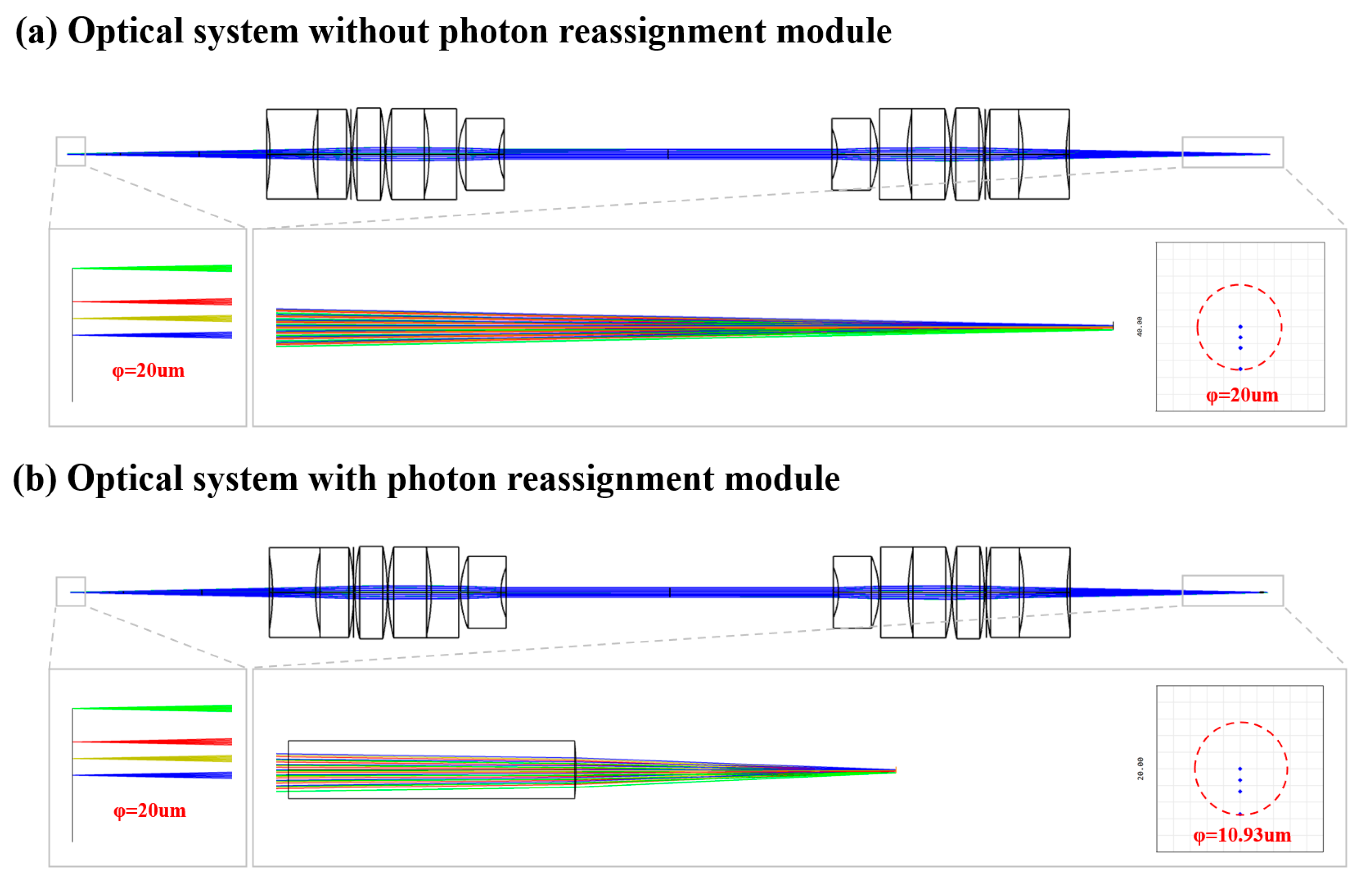

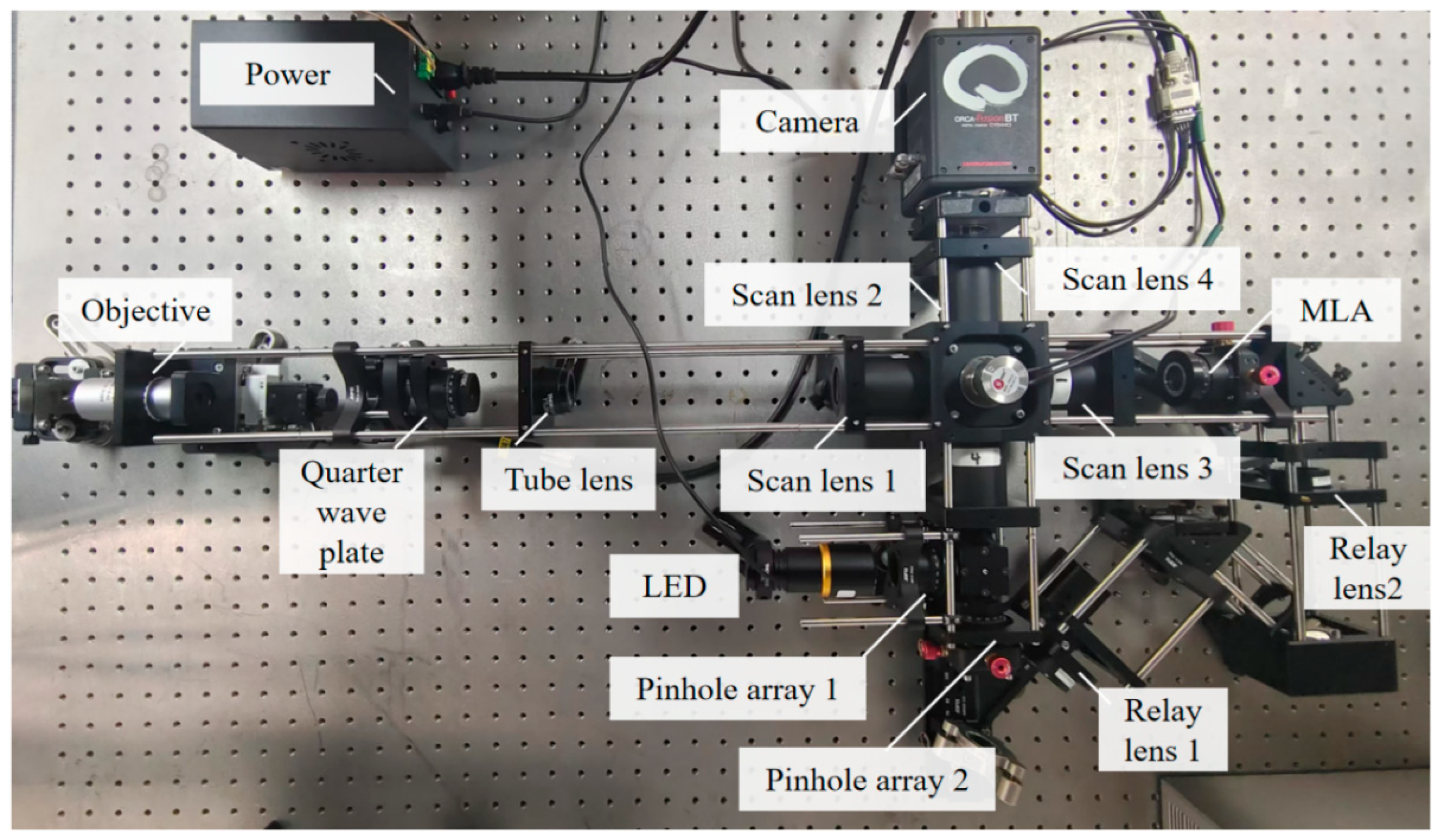
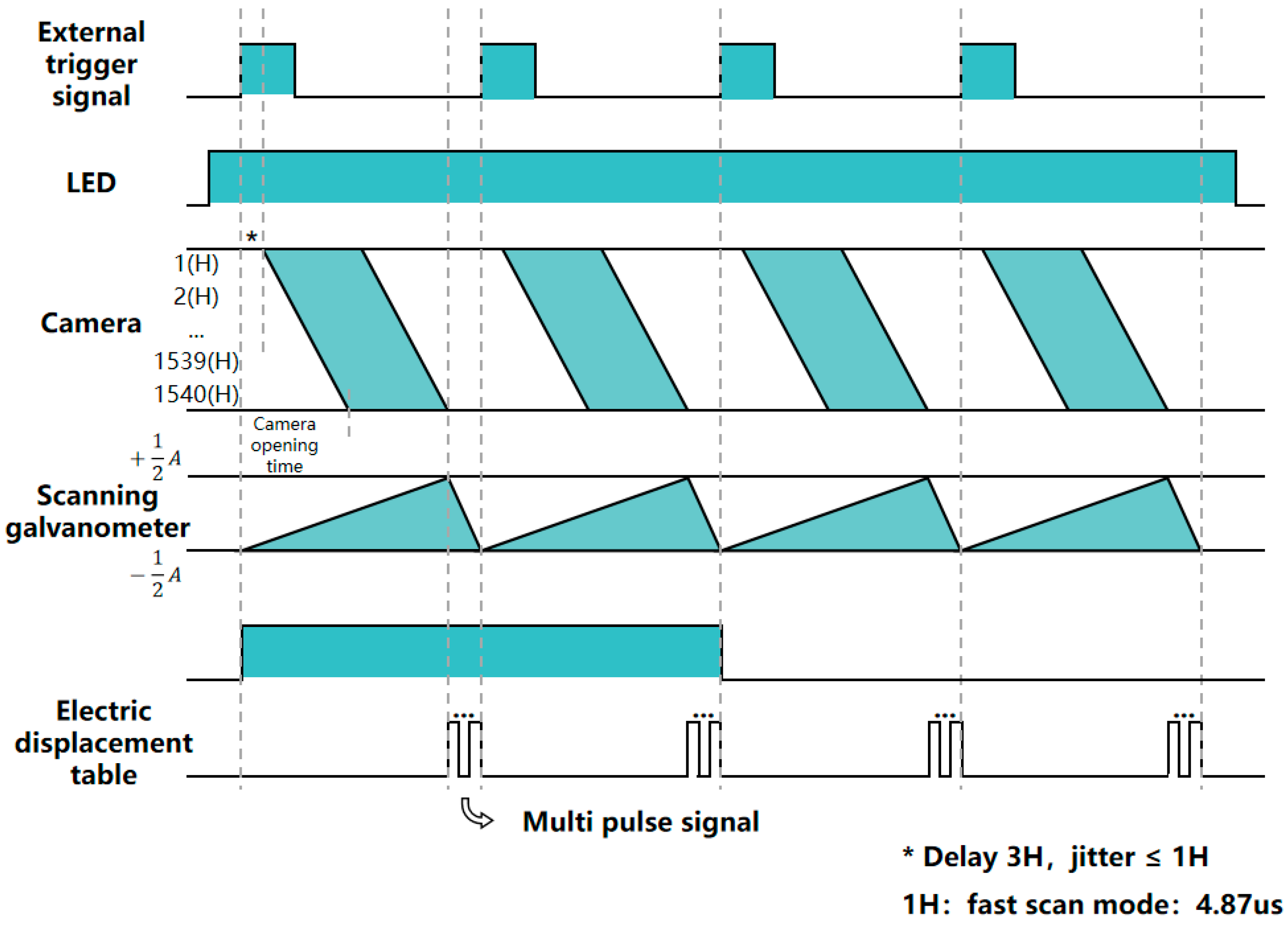
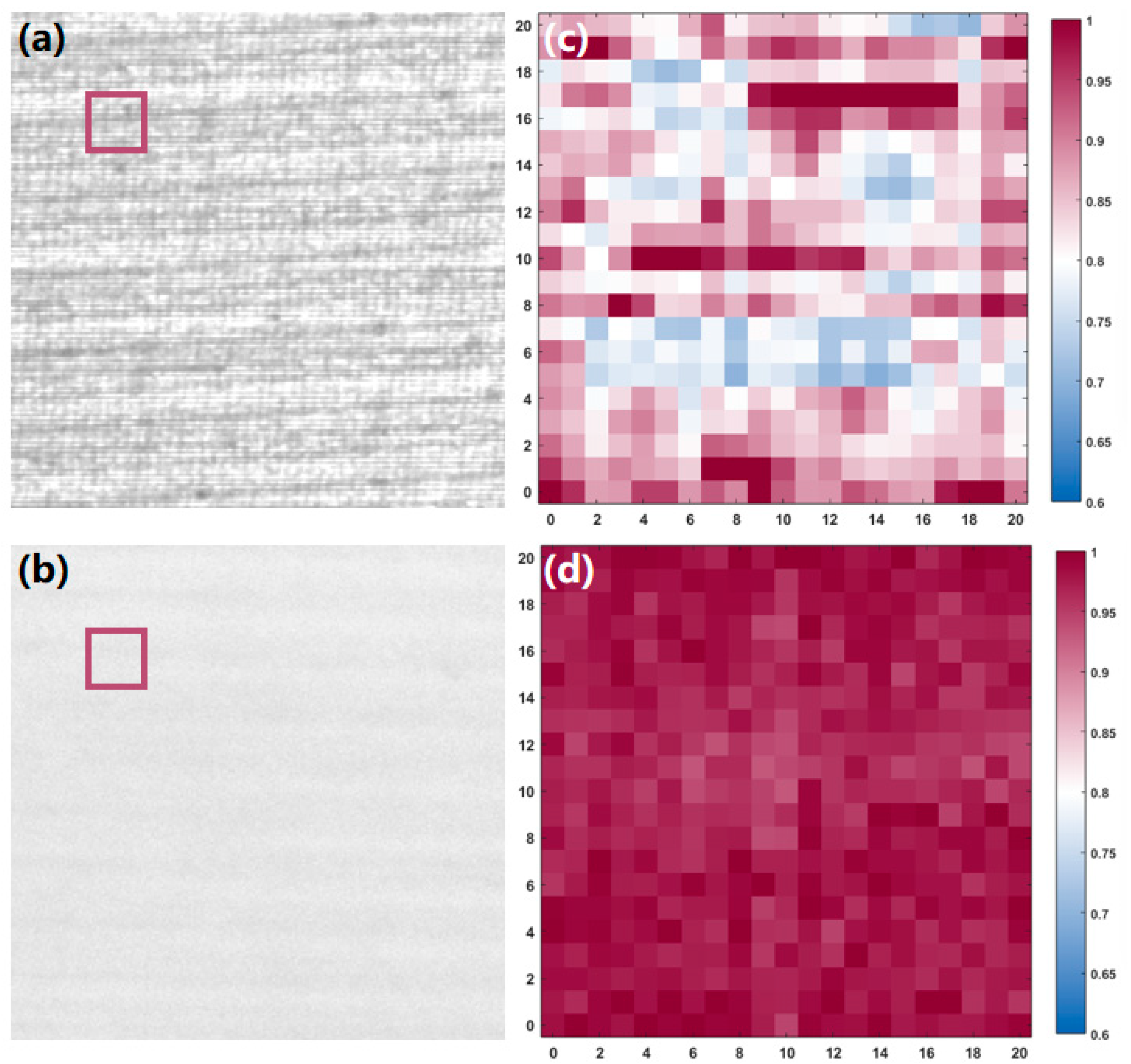
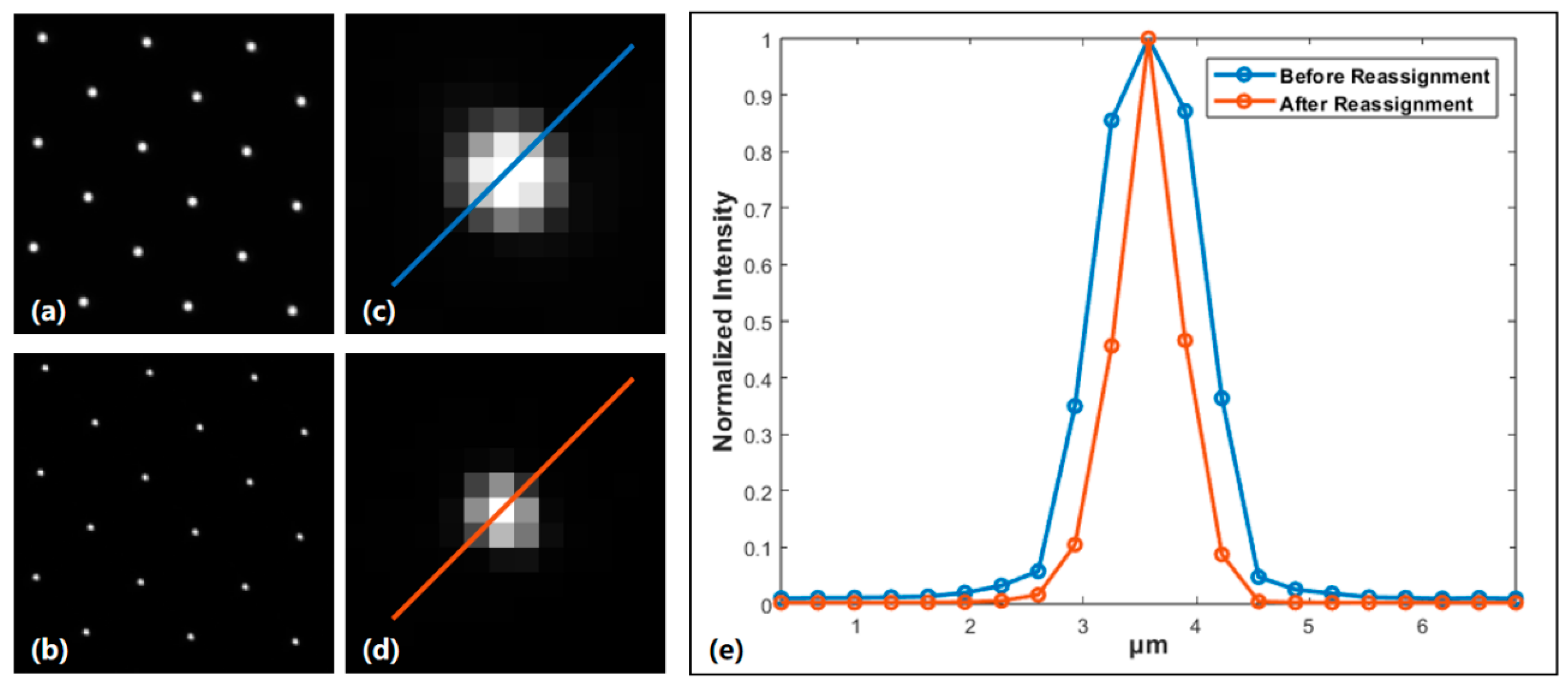
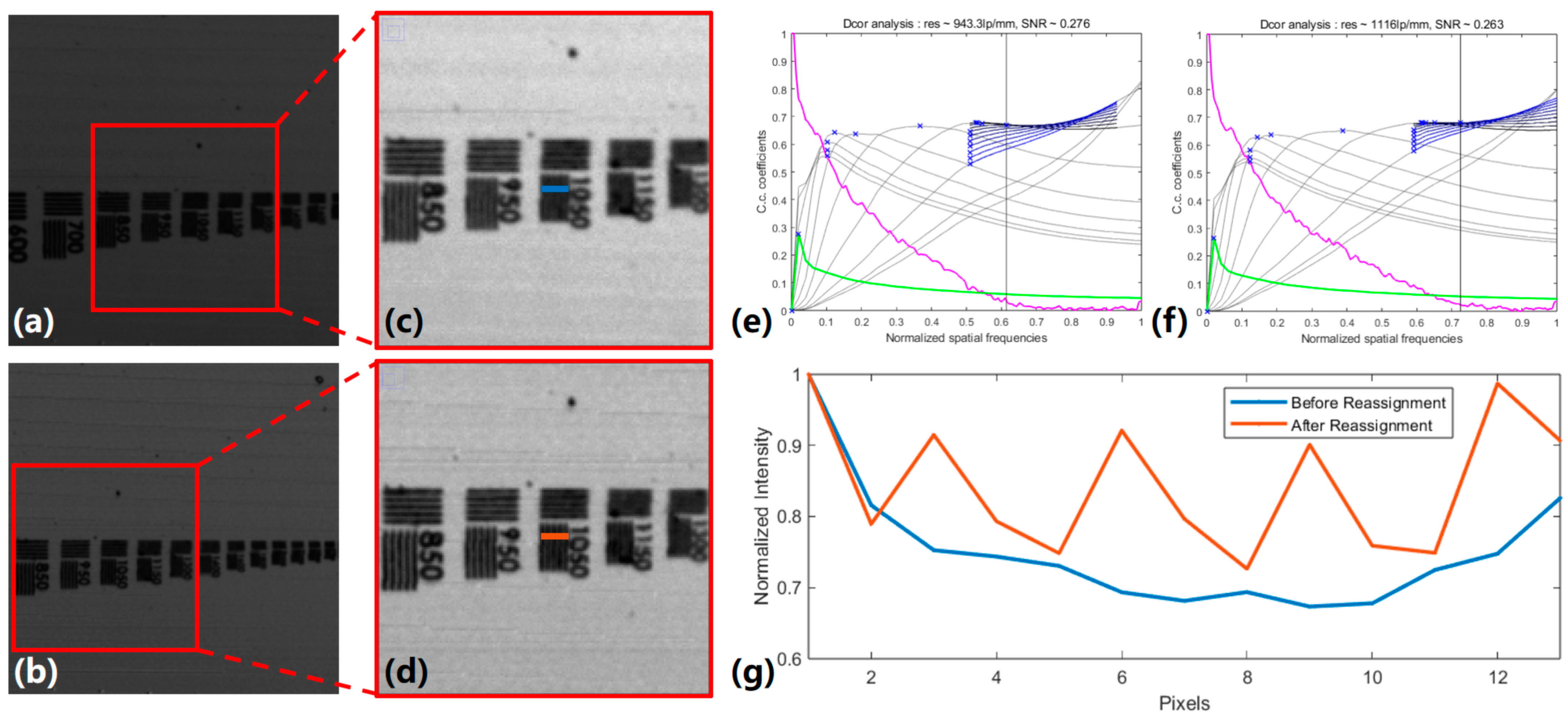


| No. | Component Specification | Manufacturer |
|---|---|---|
| 1 | Telecentric LED source, ESCL-PX20-5W-R, dominant wavelength 635 nm | Kunshan Jiji Visual Software Co., Ltd., Shenzhen, China |
| 2 | galvanometer, SS-9310D | Sunny, Beijing, China |
| 3 | polarization beam splitter, PBS642, anti-reflection coating 620–1000 nm | LBTEK, Shenzhen, China |
| 4 | quarter-wave plate, QWP25-633A-M | LBTEK, Shenzhen, China |
| 5 | F-theta lenses | NOVEL, Ningbo, China |
| 6 | Relay lens, E0351-180 | Domilight, Nanjing, China |
| 7 | Pinhole array1, diameter of a single point 18 μm | Wiener (Shenzhen) Trading Co., Ltd., Shenzhen, China |
| 8 | Pinhole array2, diameter of a single point 50 μm | |
| 9 | Micro lens array, APO-Q-P200-R2.23 | Advanced micro-optic systems GmbH, Saarbrücken, Germany |
| 10 | Tube lens, TTL200 | Thorlabs, Newton, NJ, USA |
| 11 | objective, MY-20X-804, 20×, NA0.42 | Mitutoyo, Kanagawa, Japan |
| 12 | camera, C15440-20UP, 2304 × 2304 pixels | HAMAMATSU, Hamamatsu, Japan |
| 13 | Ground Data Collection Card, PCIe-6738 | NI, Austin, TX, USA |
| 14 | Laser, 647 nm, 100 mw | Coherent, Saxonburg, PA, USA |
| 15 | Rotating diffuser, ODDA101-1500 | JCOPTiX, Nanjing, China |
| 16 | Micro lens array1 and 2, APO-Q-P300-R0.94 | Advanced micro-optic systems GmbH, Saarbrücken, Germany |
| 17 | Fourier lens, OLD3270-T2M, f = 300 mm | JCOPTiX, Nanjing, China |
Disclaimer/Publisher’s Note: The statements, opinions and data contained in all publications are solely those of the individual author(s) and contributor(s) and not of MDPI and/or the editor(s). MDPI and/or the editor(s) disclaim responsibility for any injury to people or property resulting from any ideas, methods, instructions or products referred to in the content. |
© 2024 by the authors. Licensee MDPI, Basel, Switzerland. This article is an open access article distributed under the terms and conditions of the Creative Commons Attribution (CC BY) license (https://creativecommons.org/licenses/by/4.0/).
Share and Cite
Hu, H.; He, N.; Du, K.; Zhu, Y.; Zhou, D.; Mi, Y.; Chen, Y.; Ma, J.; Chen, Y.; Kuang, C. Research on Reflective High-Speed Multi-Point Confocal Microscopy System. Photonics 2025, 12, 22. https://doi.org/10.3390/photonics12010022
Hu H, He N, Du K, Zhu Y, Zhou D, Mi Y, Chen Y, Ma J, Chen Y, Kuang C. Research on Reflective High-Speed Multi-Point Confocal Microscopy System. Photonics. 2025; 12(1):22. https://doi.org/10.3390/photonics12010022
Chicago/Turabian StyleHu, Huiqin, Ning He, Kuangwei Du, Yukun Zhu, Dakai Zhou, Yuan Mi, Yunbo Chen, Junteng Ma, Youhua Chen, and Cuifang Kuang. 2025. "Research on Reflective High-Speed Multi-Point Confocal Microscopy System" Photonics 12, no. 1: 22. https://doi.org/10.3390/photonics12010022
APA StyleHu, H., He, N., Du, K., Zhu, Y., Zhou, D., Mi, Y., Chen, Y., Ma, J., Chen, Y., & Kuang, C. (2025). Research on Reflective High-Speed Multi-Point Confocal Microscopy System. Photonics, 12(1), 22. https://doi.org/10.3390/photonics12010022





